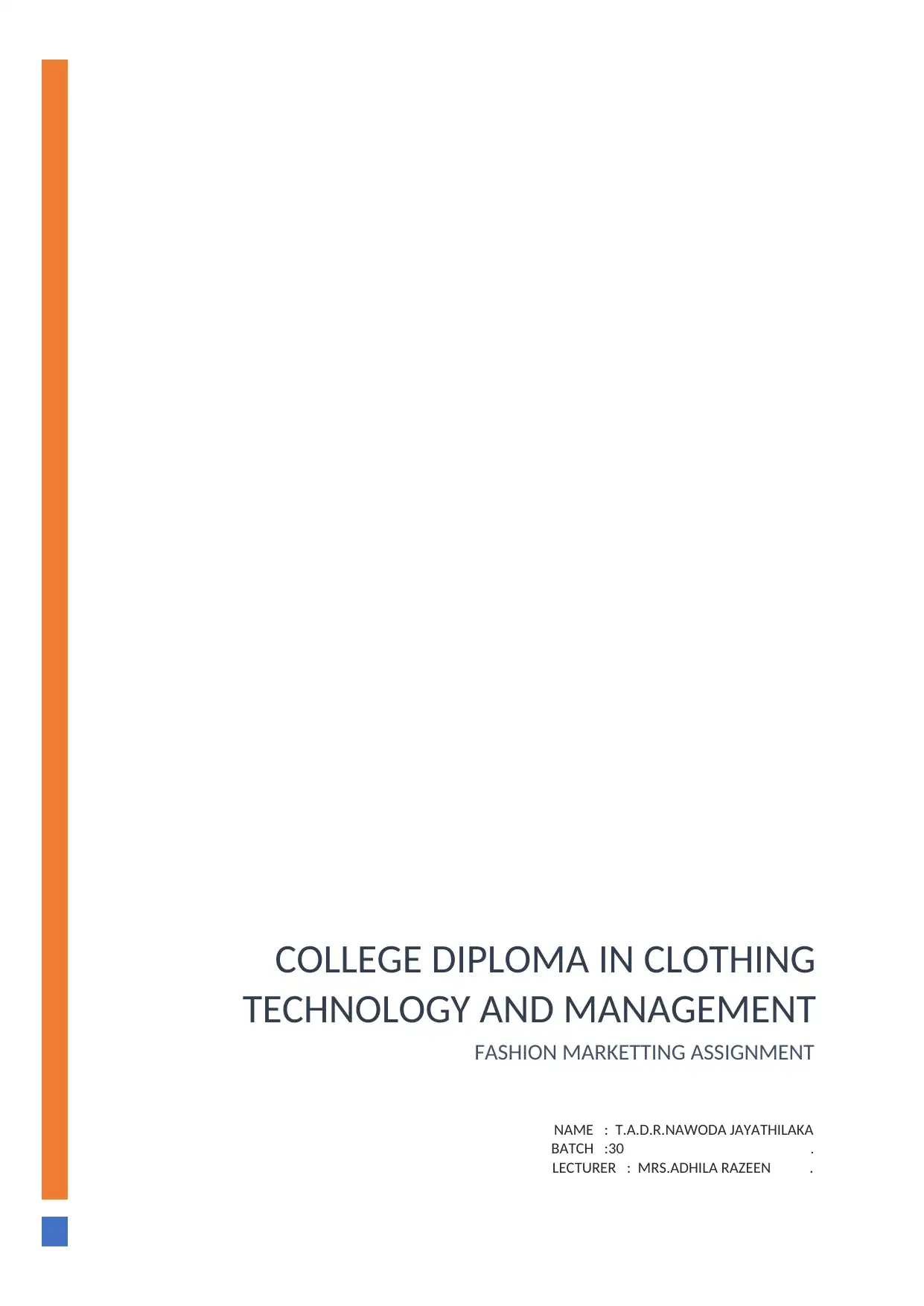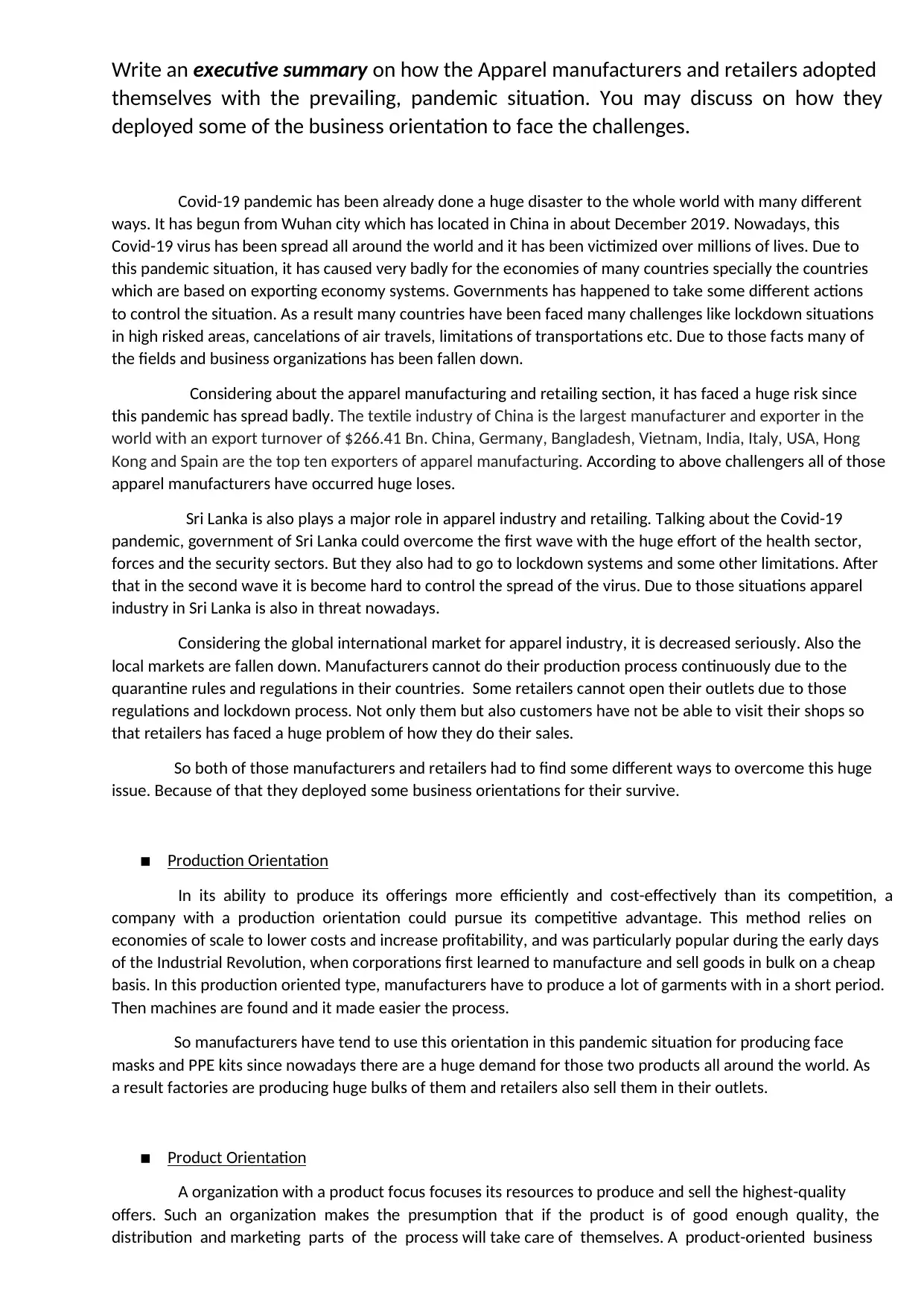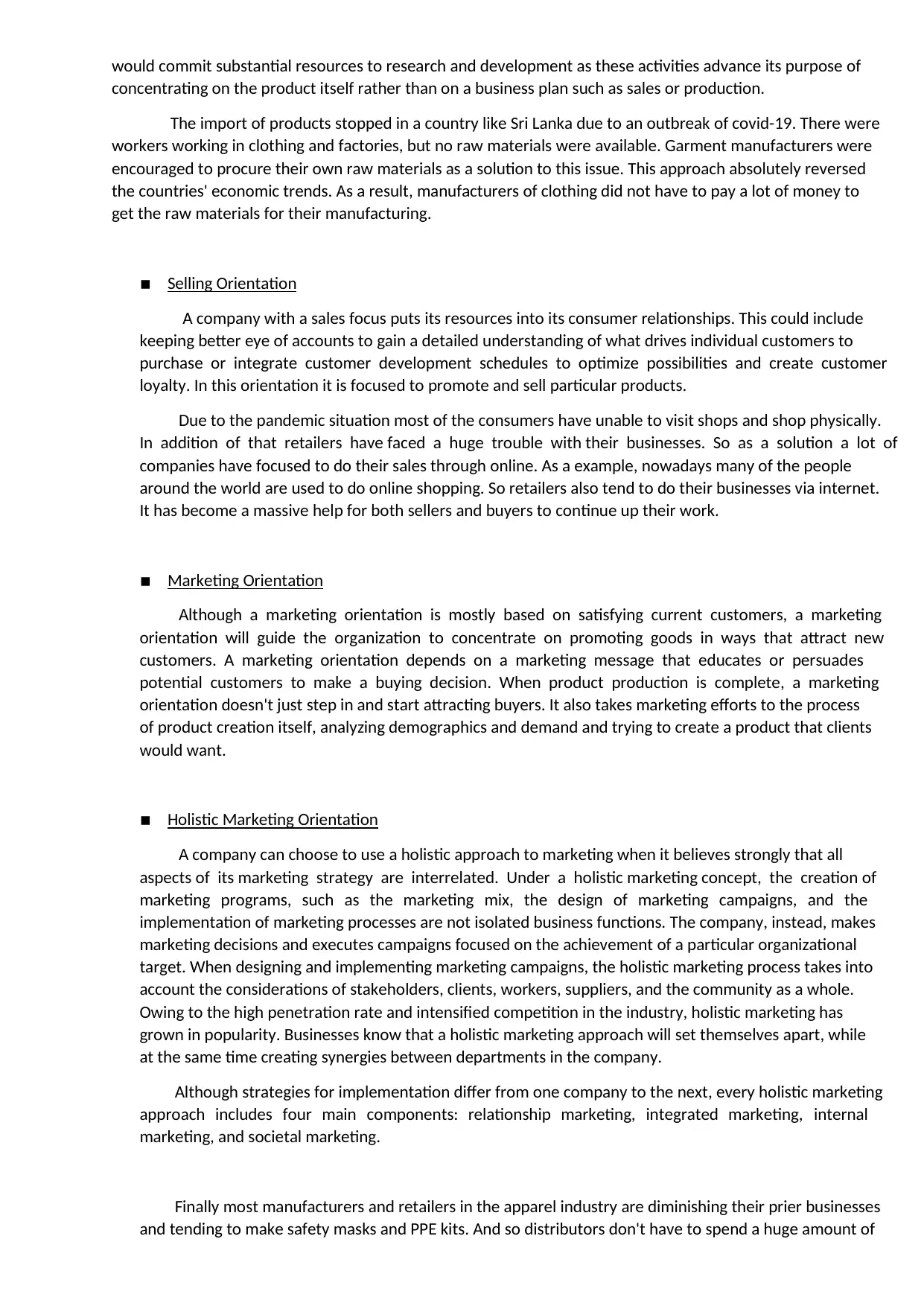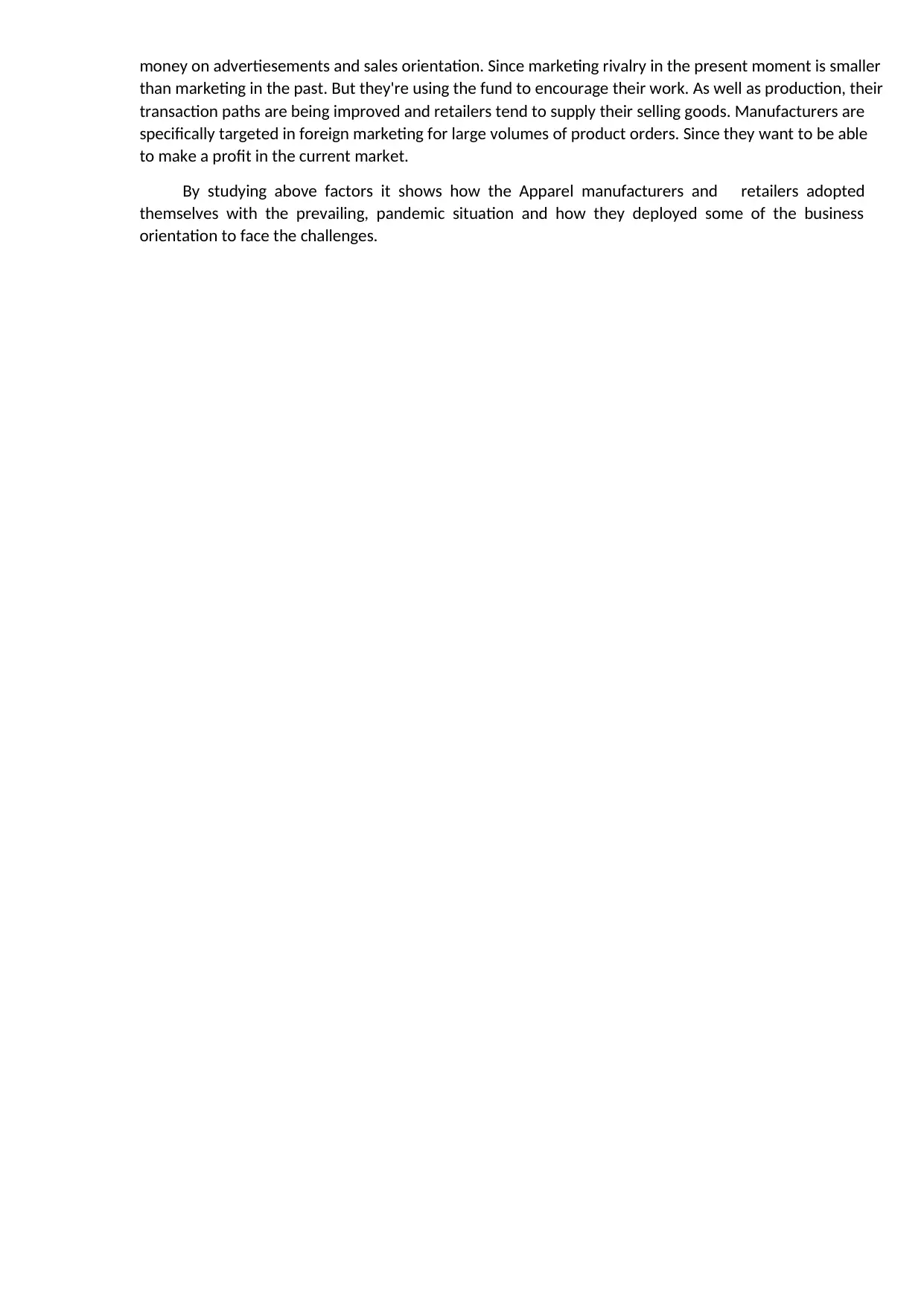Fashion Marketing: Apparel Industry Adaptation to Pandemic Challenges
VerifiedAdded on 2021/06/22
|4
|1431
|64
Report
AI Summary
This report provides an executive summary analyzing the impact of the COVID-19 pandemic on the apparel industry, focusing on the adaptations of manufacturers and retailers. It examines the challenges faced, including lockdowns, supply chain disruptions, and decreased consumer demand, and how these were addressed. The report explores the deployment of various business orientations, such as production, product, selling, marketing, and holistic marketing, to navigate the crisis. It highlights how manufacturers shifted towards producing face masks and PPE kits, while retailers embraced online sales strategies. The analysis covers the shift in focus towards safety products, improvements in transaction paths, and targeted foreign marketing. The report concludes by illustrating how the apparel industry leveraged these strategies to survive and adapt to the prevailing pandemic situation.

COLLEGE DIPLOMA IN CLOTHING
TECHNOLOGY AND MANAGEMENT
FASHION MARKETTING ASSIGNMENT
NAME : T.A.D.R.NAWODA JAYATHILAKA
BATCH :30 .
LECTURER : MRS.ADHILA RAZEEN .
TECHNOLOGY AND MANAGEMENT
FASHION MARKETTING ASSIGNMENT
NAME : T.A.D.R.NAWODA JAYATHILAKA
BATCH :30 .
LECTURER : MRS.ADHILA RAZEEN .
Paraphrase This Document
Need a fresh take? Get an instant paraphrase of this document with our AI Paraphraser

Write an executive summary on how the Apparel manufacturers and retailers adopted
themselves with the prevailing, pandemic situation. You may discuss on how they
deployed some of the business orientation to face the challenges.
Covid-19 pandemic has been already done a huge disaster to the whole world with many different
ways. It has begun from Wuhan city which has located in China in about December 2019. Nowadays, this
Covid-19 virus has been spread all around the world and it has been victimized over millions of lives. Due to
this pandemic situation, it has caused very badly for the economies of many countries specially the countries
which are based on exporting economy systems. Governments has happened to take some different actions
to control the situation. As a result many countries have been faced many challenges like lockdown situations
in high risked areas, cancelations of air travels, limitations of transportations etc. Due to those facts many of
the fields and business organizations has been fallen down.
Considering about the apparel manufacturing and retailing section, it has faced a huge risk since
this pandemic has spread badly. The textile industry of China is the largest manufacturer and exporter in the
world with an export turnover of $266.41 Bn. China, Germany, Bangladesh, Vietnam, India, Italy, USA, Hong
Kong and Spain are the top ten exporters of apparel manufacturing. According to above challengers all of those
apparel manufacturers have occurred huge loses.
Sri Lanka is also plays a major role in apparel industry and retailing. Talking about the Covid-19
pandemic, government of Sri Lanka could overcome the first wave with the huge effort of the health sector,
forces and the security sectors. But they also had to go to lockdown systems and some other limitations. After
that in the second wave it is become hard to control the spread of the virus. Due to those situations apparel
industry in Sri Lanka is also in threat nowadays.
Considering the global international market for apparel industry, it is decreased seriously. Also the
local markets are fallen down. Manufacturers cannot do their production process continuously due to the
quarantine rules and regulations in their countries. Some retailers cannot open their outlets due to those
regulations and lockdown process. Not only them but also customers have not be able to visit their shops so
that retailers has faced a huge problem of how they do their sales.
So both of those manufacturers and retailers had to find some different ways to overcome this huge
issue. Because of that they deployed some business orientations for their survive.
▪ Production Orientation
In its ability to produce its offerings more efficiently and cost-effectively than its competition, a
company with a production orientation could pursue its competitive advantage. This method relies on
economies of scale to lower costs and increase profitability, and was particularly popular during the early days
of the Industrial Revolution, when corporations first learned to manufacture and sell goods in bulk on a cheap
basis. In this production oriented type, manufacturers have to produce a lot of garments with in a short period.
Then machines are found and it made easier the process.
So manufacturers have tend to use this orientation in this pandemic situation for producing face
masks and PPE kits since nowadays there are a huge demand for those two products all around the world. As
a result factories are producing huge bulks of them and retailers also sell them in their outlets.
▪ Product Orientation
A organization with a product focus focuses its resources to produce and sell the highest-quality
offers. Such an organization makes the presumption that if the product is of good enough quality, the
distribution and marketing parts of the process will take care of themselves. A product-oriented business
themselves with the prevailing, pandemic situation. You may discuss on how they
deployed some of the business orientation to face the challenges.
Covid-19 pandemic has been already done a huge disaster to the whole world with many different
ways. It has begun from Wuhan city which has located in China in about December 2019. Nowadays, this
Covid-19 virus has been spread all around the world and it has been victimized over millions of lives. Due to
this pandemic situation, it has caused very badly for the economies of many countries specially the countries
which are based on exporting economy systems. Governments has happened to take some different actions
to control the situation. As a result many countries have been faced many challenges like lockdown situations
in high risked areas, cancelations of air travels, limitations of transportations etc. Due to those facts many of
the fields and business organizations has been fallen down.
Considering about the apparel manufacturing and retailing section, it has faced a huge risk since
this pandemic has spread badly. The textile industry of China is the largest manufacturer and exporter in the
world with an export turnover of $266.41 Bn. China, Germany, Bangladesh, Vietnam, India, Italy, USA, Hong
Kong and Spain are the top ten exporters of apparel manufacturing. According to above challengers all of those
apparel manufacturers have occurred huge loses.
Sri Lanka is also plays a major role in apparel industry and retailing. Talking about the Covid-19
pandemic, government of Sri Lanka could overcome the first wave with the huge effort of the health sector,
forces and the security sectors. But they also had to go to lockdown systems and some other limitations. After
that in the second wave it is become hard to control the spread of the virus. Due to those situations apparel
industry in Sri Lanka is also in threat nowadays.
Considering the global international market for apparel industry, it is decreased seriously. Also the
local markets are fallen down. Manufacturers cannot do their production process continuously due to the
quarantine rules and regulations in their countries. Some retailers cannot open their outlets due to those
regulations and lockdown process. Not only them but also customers have not be able to visit their shops so
that retailers has faced a huge problem of how they do their sales.
So both of those manufacturers and retailers had to find some different ways to overcome this huge
issue. Because of that they deployed some business orientations for their survive.
▪ Production Orientation
In its ability to produce its offerings more efficiently and cost-effectively than its competition, a
company with a production orientation could pursue its competitive advantage. This method relies on
economies of scale to lower costs and increase profitability, and was particularly popular during the early days
of the Industrial Revolution, when corporations first learned to manufacture and sell goods in bulk on a cheap
basis. In this production oriented type, manufacturers have to produce a lot of garments with in a short period.
Then machines are found and it made easier the process.
So manufacturers have tend to use this orientation in this pandemic situation for producing face
masks and PPE kits since nowadays there are a huge demand for those two products all around the world. As
a result factories are producing huge bulks of them and retailers also sell them in their outlets.
▪ Product Orientation
A organization with a product focus focuses its resources to produce and sell the highest-quality
offers. Such an organization makes the presumption that if the product is of good enough quality, the
distribution and marketing parts of the process will take care of themselves. A product-oriented business

would commit substantial resources to research and development as these activities advance its purpose of
concentrating on the product itself rather than on a business plan such as sales or production.
The import of products stopped in a country like Sri Lanka due to an outbreak of covid-19. There were
workers working in clothing and factories, but no raw materials were available. Garment manufacturers were
encouraged to procure their own raw materials as a solution to this issue. This approach absolutely reversed
the countries' economic trends. As a result, manufacturers of clothing did not have to pay a lot of money to
get the raw materials for their manufacturing.
▪ Selling Orientation
A company with a sales focus puts its resources into its consumer relationships. This could include
keeping better eye of accounts to gain a detailed understanding of what drives individual customers to
purchase or integrate customer development schedules to optimize possibilities and create customer
loyalty. In this orientation it is focused to promote and sell particular products.
Due to the pandemic situation most of the consumers have unable to visit shops and shop physically.
In addition of that retailers have faced a huge trouble with their businesses. So as a solution a lot of
companies have focused to do their sales through online. As a example, nowadays many of the people
around the world are used to do online shopping. So retailers also tend to do their businesses via internet.
It has become a massive help for both sellers and buyers to continue up their work.
▪ Marketing Orientation
Although a marketing orientation is mostly based on satisfying current customers, a marketing
orientation will guide the organization to concentrate on promoting goods in ways that attract new
customers. A marketing orientation depends on a marketing message that educates or persuades
potential customers to make a buying decision. When product production is complete, a marketing
orientation doesn't just step in and start attracting buyers. It also takes marketing efforts to the process
of product creation itself, analyzing demographics and demand and trying to create a product that clients
would want.
▪ Holistic Marketing Orientation
A company can choose to use a holistic approach to marketing when it believes strongly that all
aspects of its marketing strategy are interrelated. Under a holistic marketing concept, the creation of
marketing programs, such as the marketing mix, the design of marketing campaigns, and the
implementation of marketing processes are not isolated business functions. The company, instead, makes
marketing decisions and executes campaigns focused on the achievement of a particular organizational
target. When designing and implementing marketing campaigns, the holistic marketing process takes into
account the considerations of stakeholders, clients, workers, suppliers, and the community as a whole.
Owing to the high penetration rate and intensified competition in the industry, holistic marketing has
grown in popularity. Businesses know that a holistic marketing approach will set themselves apart, while
at the same time creating synergies between departments in the company.
Although strategies for implementation differ from one company to the next, every holistic marketing
approach includes four main components: relationship marketing, integrated marketing, internal
marketing, and societal marketing.
Finally most manufacturers and retailers in the apparel industry are diminishing their prier businesses
and tending to make safety masks and PPE kits. And so distributors don't have to spend a huge amount of
concentrating on the product itself rather than on a business plan such as sales or production.
The import of products stopped in a country like Sri Lanka due to an outbreak of covid-19. There were
workers working in clothing and factories, but no raw materials were available. Garment manufacturers were
encouraged to procure their own raw materials as a solution to this issue. This approach absolutely reversed
the countries' economic trends. As a result, manufacturers of clothing did not have to pay a lot of money to
get the raw materials for their manufacturing.
▪ Selling Orientation
A company with a sales focus puts its resources into its consumer relationships. This could include
keeping better eye of accounts to gain a detailed understanding of what drives individual customers to
purchase or integrate customer development schedules to optimize possibilities and create customer
loyalty. In this orientation it is focused to promote and sell particular products.
Due to the pandemic situation most of the consumers have unable to visit shops and shop physically.
In addition of that retailers have faced a huge trouble with their businesses. So as a solution a lot of
companies have focused to do their sales through online. As a example, nowadays many of the people
around the world are used to do online shopping. So retailers also tend to do their businesses via internet.
It has become a massive help for both sellers and buyers to continue up their work.
▪ Marketing Orientation
Although a marketing orientation is mostly based on satisfying current customers, a marketing
orientation will guide the organization to concentrate on promoting goods in ways that attract new
customers. A marketing orientation depends on a marketing message that educates or persuades
potential customers to make a buying decision. When product production is complete, a marketing
orientation doesn't just step in and start attracting buyers. It also takes marketing efforts to the process
of product creation itself, analyzing demographics and demand and trying to create a product that clients
would want.
▪ Holistic Marketing Orientation
A company can choose to use a holistic approach to marketing when it believes strongly that all
aspects of its marketing strategy are interrelated. Under a holistic marketing concept, the creation of
marketing programs, such as the marketing mix, the design of marketing campaigns, and the
implementation of marketing processes are not isolated business functions. The company, instead, makes
marketing decisions and executes campaigns focused on the achievement of a particular organizational
target. When designing and implementing marketing campaigns, the holistic marketing process takes into
account the considerations of stakeholders, clients, workers, suppliers, and the community as a whole.
Owing to the high penetration rate and intensified competition in the industry, holistic marketing has
grown in popularity. Businesses know that a holistic marketing approach will set themselves apart, while
at the same time creating synergies between departments in the company.
Although strategies for implementation differ from one company to the next, every holistic marketing
approach includes four main components: relationship marketing, integrated marketing, internal
marketing, and societal marketing.
Finally most manufacturers and retailers in the apparel industry are diminishing their prier businesses
and tending to make safety masks and PPE kits. And so distributors don't have to spend a huge amount of
⊘ This is a preview!⊘
Do you want full access?
Subscribe today to unlock all pages.

Trusted by 1+ million students worldwide

money on advertiesements and sales orientation. Since marketing rivalry in the present moment is smaller
than marketing in the past. But they're using the fund to encourage their work. As well as production, their
transaction paths are being improved and retailers tend to supply their selling goods. Manufacturers are
specifically targeted in foreign marketing for large volumes of product orders. Since they want to be able
to make a profit in the current market.
By studying above factors it shows how the Apparel manufacturers and retailers adopted
themselves with the prevailing, pandemic situation and how they deployed some of the business
orientation to face the challenges.
than marketing in the past. But they're using the fund to encourage their work. As well as production, their
transaction paths are being improved and retailers tend to supply their selling goods. Manufacturers are
specifically targeted in foreign marketing for large volumes of product orders. Since they want to be able
to make a profit in the current market.
By studying above factors it shows how the Apparel manufacturers and retailers adopted
themselves with the prevailing, pandemic situation and how they deployed some of the business
orientation to face the challenges.
1 out of 4
Related Documents
Your All-in-One AI-Powered Toolkit for Academic Success.
+13062052269
info@desklib.com
Available 24*7 on WhatsApp / Email
![[object Object]](/_next/static/media/star-bottom.7253800d.svg)
Unlock your academic potential
Copyright © 2020–2025 A2Z Services. All Rights Reserved. Developed and managed by ZUCOL.




